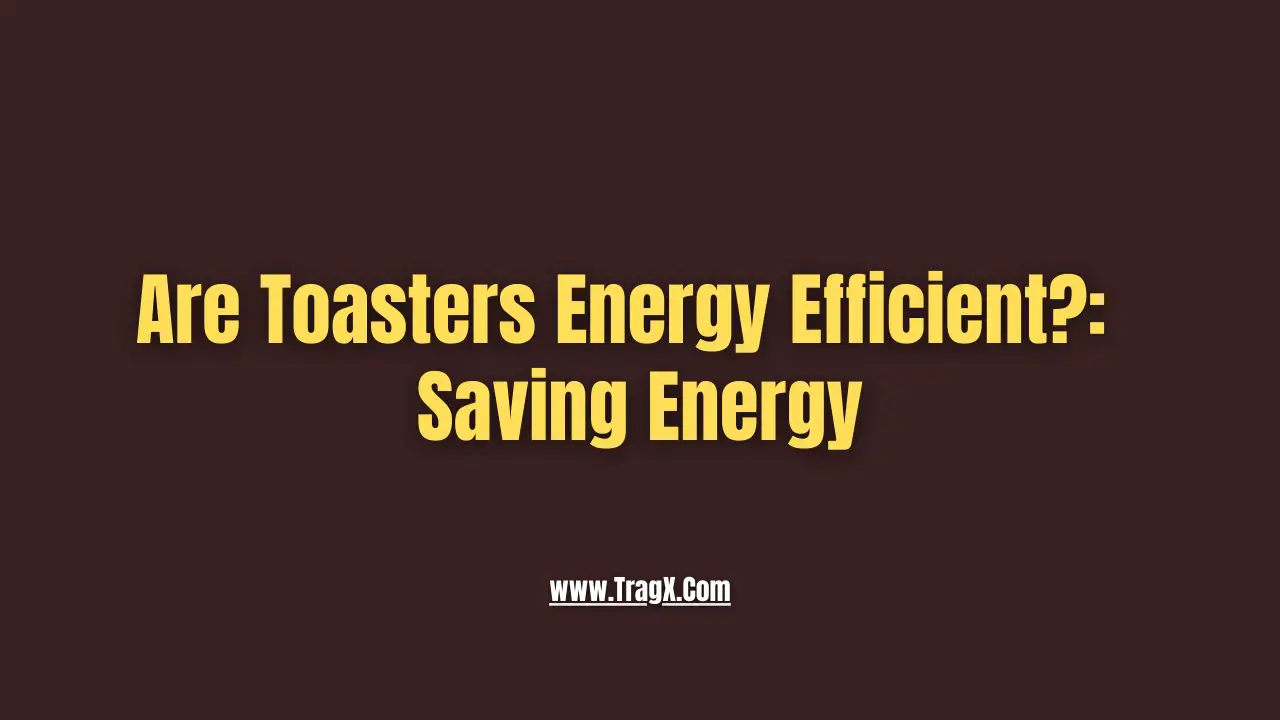Hello Everyone, Toasters have been a staple in kitchens around the world for decades, providing quick and easy ways to enjoy crispy and delicious toast. However, with growing concerns about energy consumption and sustainability, many wonder if toasters are truly energy-efficient appliances. Let’s explore the facts and debunk the myths surrounding the energy efficiency of toasters.
The Energy Consumption of Toasters: A Closer Look
To understand the energy efficiency of toasters, we need to examine their power usage during operation. Most standard toasters have a wattage range of 600 to 1200 watts. When you turn on the toaster, it rapidly heats up the heating elements to toast the bread or bagels.
On average, a toaster takes about 1 to 3 minutes to toast bread, depending on your preferred toasting level. During this short period, the toaster’s power consumption varies based on the wattage and duration of use. For example, if your toaster operates at 1000 watts and you toast a slice of bread for 2 minutes, it would consume approximately 33.3 watt-hours of electricity.
Comparing Toasters to Other Appliances:
When considering energy efficiency, it’s essential to compare toasters to other kitchen appliances. In comparison to larger appliances like ovens and microwaves, toasters are relatively more energy-efficient for toasting purposes.
To put things into perspective, a standard electric oven typically operates at 2400 to 5000 watts, consuming significantly more energy than a toaster. Using an oven to toast a few slices of bread would be inefficient, as it requires more power and takes longer to preheat. Microwaves, on the other hand, consume similar or slightly more power than toasters during use.
Energy Saving Tips for Toasters:
While toasters are relatively energy-efficient, there are ways to maximize their energy-saving potential:
- Select the Right Wattage: Choose a toaster with the appropriate wattage for your toasting needs. Lower wattage models are available and can be just as effective for toasting a few slices of bread or bagels, resulting in reduced energy consumption.
- Toast Multiple Slices Together: Whenever possible, toast multiple slices of bread or bagels together. Toasting several slices at once reduces the total operating time of the toaster, minimizing energy usage.
- Use Timer Settings Wisely: Select accurate toasting times based on your preferences. Avoid over-toasting, as it can waste energy and lead to burnt toast.
- Keep It Clean: Regularly clean your toaster to ensure efficient heat transfer. Removing crumbs and debris helps the toaster work more effectively, reducing the need for longer toasting times.
- Avoid Preheating: Unlike larger appliances, toasters do not require preheating. Simply insert the bread or bagels and start toasting immediately, saving time and energy.
- Adjust Shade Settings: Be mindful of your preferred toasting level. Adjusting the shade settings according to your liking avoids unnecessary toasting time.
- Unplug After Use: Toasters consume a small amount of energy even in standby mode. Unplug the toaster after use to eliminate this standby energy consumption.
- Invest in Energy-Efficient Models: When purchasing a new toaster, consider energy-efficient models with features designed for better energy usage.
By following these energy-saving tips, you can make your toaster more efficient and reduce your overall energy consumption in the kitchen. Small adjustments to your toasting habits can lead to significant energy savings over time without compromising on the deliciousness of your perfectly toasted treats.
How can I make my toaster more energy efficient?
Making your toaster more energy-efficient is a simple yet impactful way to reduce energy consumption in your kitchen. Here are some SEO-optimized tips to achieve greater energy efficiency with your toaster:
- Right-Sizing Wattage: Consider investing in a toaster with the appropriate wattage for your toasting needs. Lower wattage models are available and can be just as effective for toasting a few slices of bread or bagels. By matching the toaster’s wattage to your usage requirements, you can avoid unnecessary energy consumption.
- Toast Multiple Slices: Whenever possible, toast multiple slices of bread or bagels together. Toasting several slices at once reduces the total operating time of the toaster, minimizing energy usage. However, ensure that the toaster can accommodate multiple slices without overcrowding, as even toasting requires proper air circulation.
By implementing these energy-saving strategies, you can make your toaster more energy-efficient and contribute to a greener and more sustainable kitchen. Simple adjustments to your toasting habits can lead to significant energy savings over time, without compromising on the deliciousness of your perfectly toasted treats.
Benefits of toaster energy efficiency
- Reduced Energy Consumption: Energy-efficient toasters consume less electricity during operation, leading to lower energy bills and reduced environmental impact.
- Cost Savings: By using an energy-efficient toaster, you can save money on your utility bills, contributing to long-term cost savings.
- Environmentally Friendly: Toasters with higher energy efficiency help reduce greenhouse gas emissions and promote a greener, more sustainable environment.
- Quick Operation: Energy-efficient toasters often have rapid heating elements, allowing for quick and efficient toasting, saving both time and energy.
- Better Resource Management: Energy-efficient toasters optimize energy usage, leading to better resource management and reduced strain on power grids.
- Extended Appliance Lifespan: Energy-efficient toasters tend to operate at lower temperatures, potentially extending the lifespan of the heating elements and the appliance overall.
- Versatile Toasting Options: Many energy-efficient toasters come with adjustable shade settings, allowing you to customize your toasting preferences while still being efficient in energy usage.
- User-Friendly Features: Energy-efficient toasters often incorporate user-friendly controls and intuitive designs, enhancing the toasting experience without sacrificing efficiency.
- Ideal for Small Spaces: With compact and space-saving designs, energy-efficient toasters are perfect for kitchens with limited counter space.
- Contribution to Energy Conservation: Supporting energy-efficient appliances, such as toasters, encourages manufacturers to invest in more sustainable technologies, promoting overall energy conservation.
By embracing the benefits of toaster energy efficiency, you not only save money and energy but also play a part in preserving the environment for future generations. Investing in an energy-efficient toaster contributes to a more sustainable lifestyle, making your morning toasting routine a positive step towards a greener future.
FAQ’s
Ans – Yes, toasters are generally considered energy-efficient appliances. They operate at relatively low wattages, typically ranging from 600 to 1200 watts, making them more energy-efficient than larger kitchen appliances like ovens or microwaves. Toasters rapidly heat up the heating elements to toast bread or bagels, requiring only a short duration for the toasting process. When used responsibly, toasters can contribute to energy savings and reduce your environmental impact.
Ans – The energy consumption of a toaster depends on its wattage and the duration of use. For example, a toaster operating at 1000 watts toasts a slice of bread for approximately 1 to 3 minutes. During this time, it would consume around 16.7 to 50 watt-hours of electricity. While the energy usage may seem minimal for individual toasting sessions, using energy-saving tips like toasting multiple slices together can further reduce consumption.
Ans – Absolutely! There are several ways to enhance the energy efficiency of your toaster. Firstly, consider selecting a toaster with lower wattage that matches your toasting needs. Toasting multiple slices together and adjusting shade settings wisely can also help conserve energy. Keeping your toaster clean and unplugging it after use are additional energy-saving practices. By making small adjustments to your toasting habits, you can maximize your toaster’s energy efficiency.
Ans – Energy-efficient toasters are available in a range of price points, much like standard toasters. While some energy-efficient models may have slightly higher upfront costs, they often offer long-term cost savings through reduced energy consumption. Considering the potential savings on utility bills and the positive environmental impact, investing in an energy-efficient toaster is a wise choice for budget-conscious and eco-conscious consumers alike.
Ans – Energy-efficient toasters help reduce energy consumption, resulting in lower greenhouse gas emissions and a smaller carbon footprint. By choosing energy-efficient appliances, you contribute to environmental conservation and support sustainability efforts. Energy-efficient toasters play a role in promoting greener practices and aligning with eco-friendly lifestyles, making a positive impact on the environment.
You may also like this!
- How Does a Toaster Oven Save Energy?
- How to Cook Toaster Strudel in Air Fryer?
- Are Wolf Toasters Worth the Investment?
- Are Sunbeam Toasters Good?
In Conclusion:
In summary, toasters are generally energy-efficient appliances, especially when compared to larger cooking devices. Their quick operation and relatively low wattage contribute to their energy-saving qualities.
By utilizing energy-saving tips and being mindful of your toasting habits, you can further enhance the energy efficiency of your toaster. When used responsibly, toasters remain a convenient and efficient way to enjoy delectable toast while minimizing your environmental impact.

